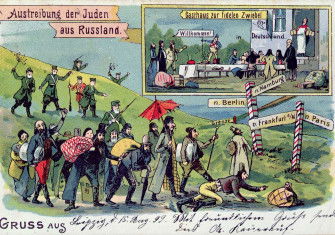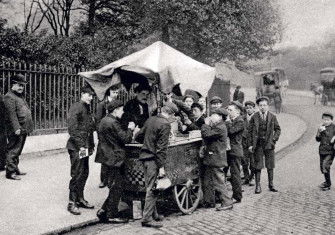What Makes a ‘Good’ Migrant?
The division of migrants into those who are of benefit to British society and those who are not has a long history.
 Migration is central to the conversation about Britain’s relationship with the European Union post-Brexit. The heated nature of this debate became apparent in September 2017, when government policy documents were leaked. They suggested that restrictions might be put in place in order to deter ‘unskilled’ EU citizens from working in the UK following Brexit. Such a policy takes its place within a long-standing narrative, which contrasts ‘good’ (‘useful’) and ‘bad’ (‘harmful’) forms of migration. The Australian ‘points system’, sometimes mooted for Britain, may be the best known example.
Migration is central to the conversation about Britain’s relationship with the European Union post-Brexit. The heated nature of this debate became apparent in September 2017, when government policy documents were leaked. They suggested that restrictions might be put in place in order to deter ‘unskilled’ EU citizens from working in the UK following Brexit. Such a policy takes its place within a long-standing narrative, which contrasts ‘good’ (‘useful’) and ‘bad’ (‘harmful’) forms of migration. The Australian ‘points system’, sometimes mooted for Britain, may be the best known example.
The division of migrants into positive and negative categories was evident in reactions to Irish migration to Britain from the 1840s onwards. By the last decade of the 19th century it was focused on one migrant group in particular: Jewish refugees from Eastern Europe. The Aliens Act of 1905, the first peacetime legislation to restrict entry into Britain, was implicitly targeted at Jewish migration into the country.
In its literature, the Conservative government, headed by Arthur Balfour, and anti-migrant campaign groups made frequent distinctions between ‘good’ and ‘bad’ Jewish migrants. The Aliens Act reflected this. One pamphlet, published immediately before the legislation was passed, wrote of excluding:
All foreigners who are criminals; who suffer from loathsome diseases; who are turned out in disgrace by their fellow countrymen; who are paupers; who fill our streets with profligacy and disorder.
It concluded: The Aliens comprise all classes; honest men anxious to work (these are welcome); criminals driven from their own country; decrepit and diseased men and women got rid of by their relatives; immoral persons; thieves; and, indeed, the refuse and scum of every city in Europe.
The distinction between good and bad minorities was apparent in the polemicist and anti-migrant campaigner Arnold White’s 1899 book The Modern Jew. White described the existing Anglo-Jewish community as being:
[As] proud of the traditions of Trafalgar or of the sovereignty of Shakespeare as any of the legitimate descendants of the people whose names are written in the Domesday Book. The whole of the class of which I am speaking are … notoriously better citizens than the average Englishmen.
Yet, at the same time, White attacked contemporary Jewish migration in the most intemperate language, referred to the expulsion of 1290 as a precedent and wrote that immigrants from Eastern Europe ‘menace the English Jews along with the rest of their fellow subjects’. At the heart of the Aliens Act was a distinction between migrants who could ‘pay their way’ and those who would be dependent upon the state. In fact, as evidenced by statistics on pauperism, Jewish migrant communities were less likely to fall back upon the provision of the state than their neighbours, being largely provided for by local Anglo-Jewish charities. But the perception of the parasitical ‘alien’ was a strong one. The Act and its provisions were explicitly targeted against ‘steerage class’ passengers – i.e. the poorest migrants.

The contrast was not confined to the Right. Divisions of ‘good’ and ‘bad’ migrant groups were also apparent on the British Left. At the TUC conferences of the mid-1890s there was heated debate over the need to prevent the entry of migrants working in trades and industries in which a proportion of ‘native’ labourers were out of work.
By the time of the Aliens Act, however, the position of the socialist and trade union movements had shifted. Some on the Left condemned the economic discrimination apparent in restrictions on entry being linked to wealth. In one 1904 pamphlet, ‘The Foreigner in England’, H. Snell wrote: ‘If you are a millionaire you are … welcome in Park Lane, but if you are a Jewish tailor flying from injustice and persecution, you are not welcome in England at all.’ It was also apparent that the restrictions of the Act would be used against political refugees fleeing autocratic regimes. The Left remained wary of migrant workers lowering wages and undoing the trade union gains of the last decade, but there was some sympathy for the poorest migrants targeted by the Act. These men and women were, after all, potential comrades in the class struggle.
Other migrant groups in the Edwardian period were characterised as ‘good’ or ‘bad’ en masse. Italian migrants were seen as violent and politically suspect. German and French arrivals were generally depicted in positive terms, although both communities were connected with economic competition in certain trades and, again, political radicalism. Chinese migrants were associated with the opium trade and depicted as a demographic threat: the 1900s were the high point of the paranoia surrounding the so-called ‘Yellow Peril’.
This narrative of where migrants stood in British society was transformed by the First World War. Germans and Austrians in Britain, who up to this point had been portrayed positively, were now suspected of disloyalty and worse. Families were broken up, with one partner, Russian or Polish, abruptly classified as a ‘friendly alien’ and their spouse, German or Austrian, an ‘enemy alien’, liable to internment. A new migrant group appeared: Belgian refugees. There was a significant amount of public sympathy for them, at least for the duration of the conflict. At the same time there were sporadic outbreaks of violence against migrant groups in British cities during the First World War – against Germans, Jews, Chinese and, in 1919, after the war had concluded, against African, Caribbean and Asian servicemen.
The dichotomy of ‘good’ and ‘bad’ migrants was, and remains, fluid and subject to external factors. The ways in which migration and the position of migrants in society are perceived is constantly changing. The period between 1899 and 1919, as in our time, illustrates how subjective these labels can be.
Daniel Renshaw is Lecturer in History at the University of Reading.






